Номер 60, страница 113 - гдз по английскому языку 11 класс учебник Афанасьева, Михеева

Авторы: Афанасьева О. В., Михеева И. В.
Тип: Student's book (Учебник)
Издательство: Просвещение
Год издания: 2014 - 2025
Уровень обучения: углублённый
Цвет обложки: белый, красный
ISBN: 978-5-09-034233-9
Популярные ГДЗ в 11 классе
Unit Two. Town and Its Architecture. Speaking - номер 60, страница 113.
№60 (с. 113)
Условие. №60 (с. 113)
скриншот условия
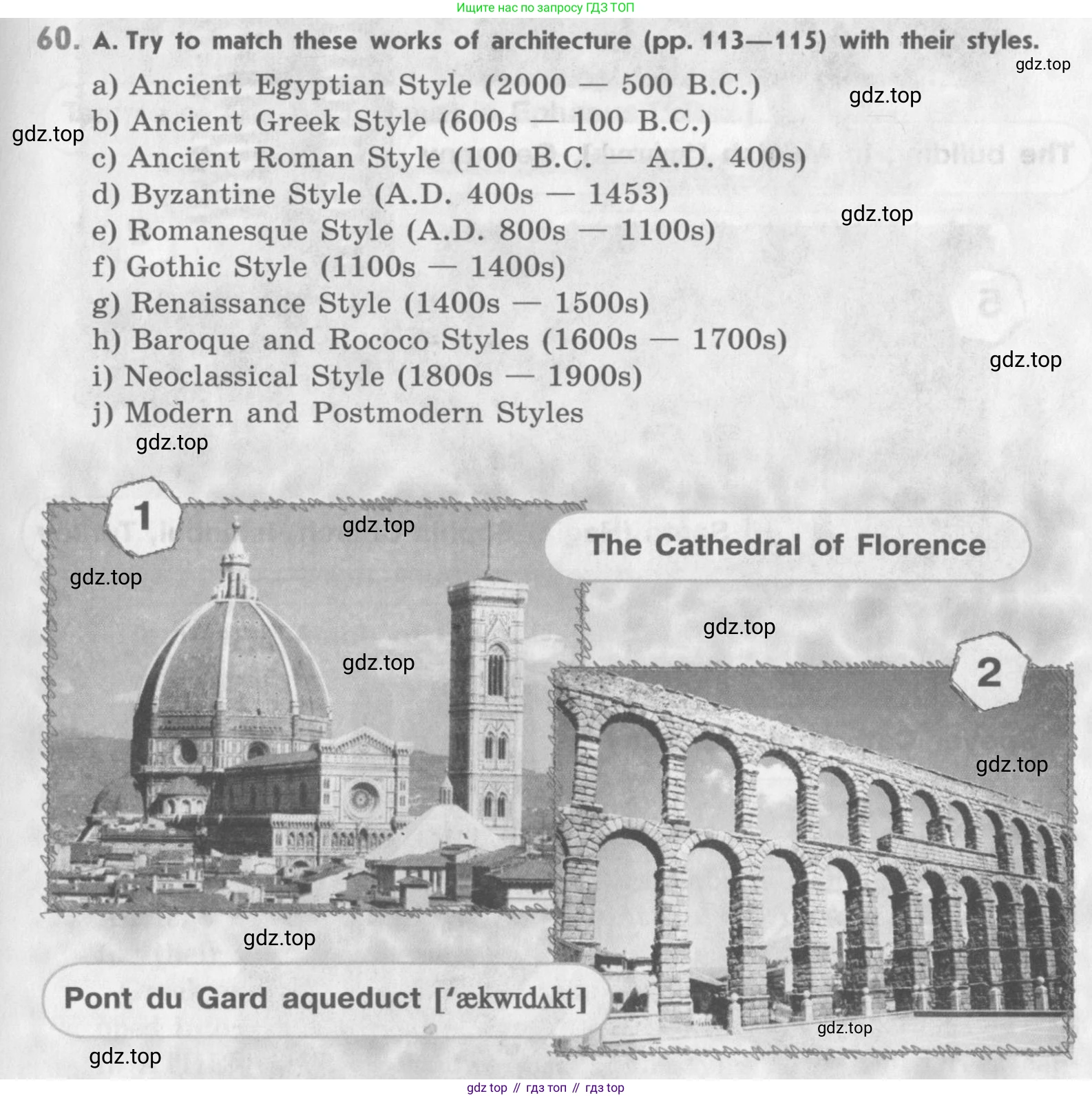
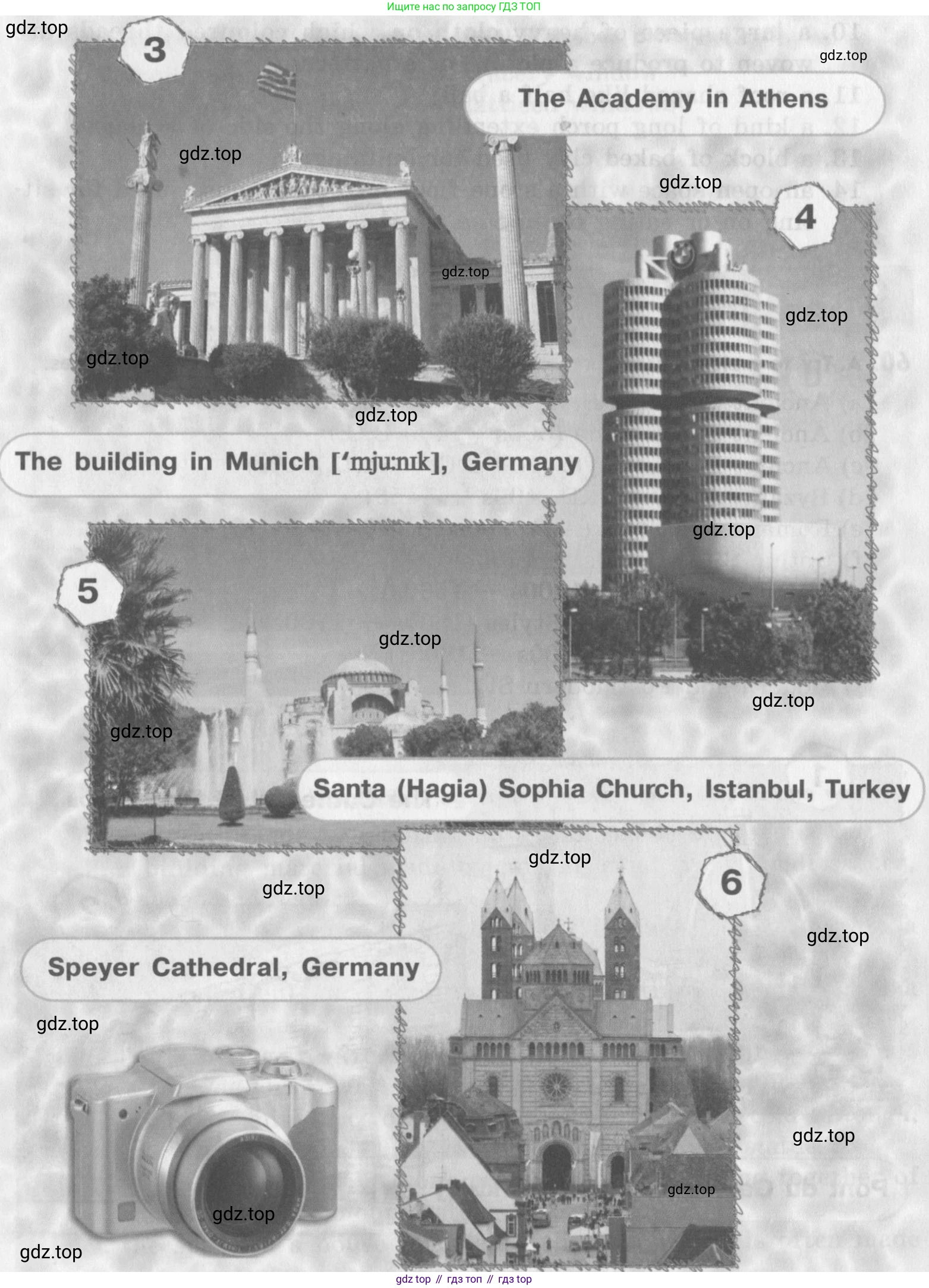
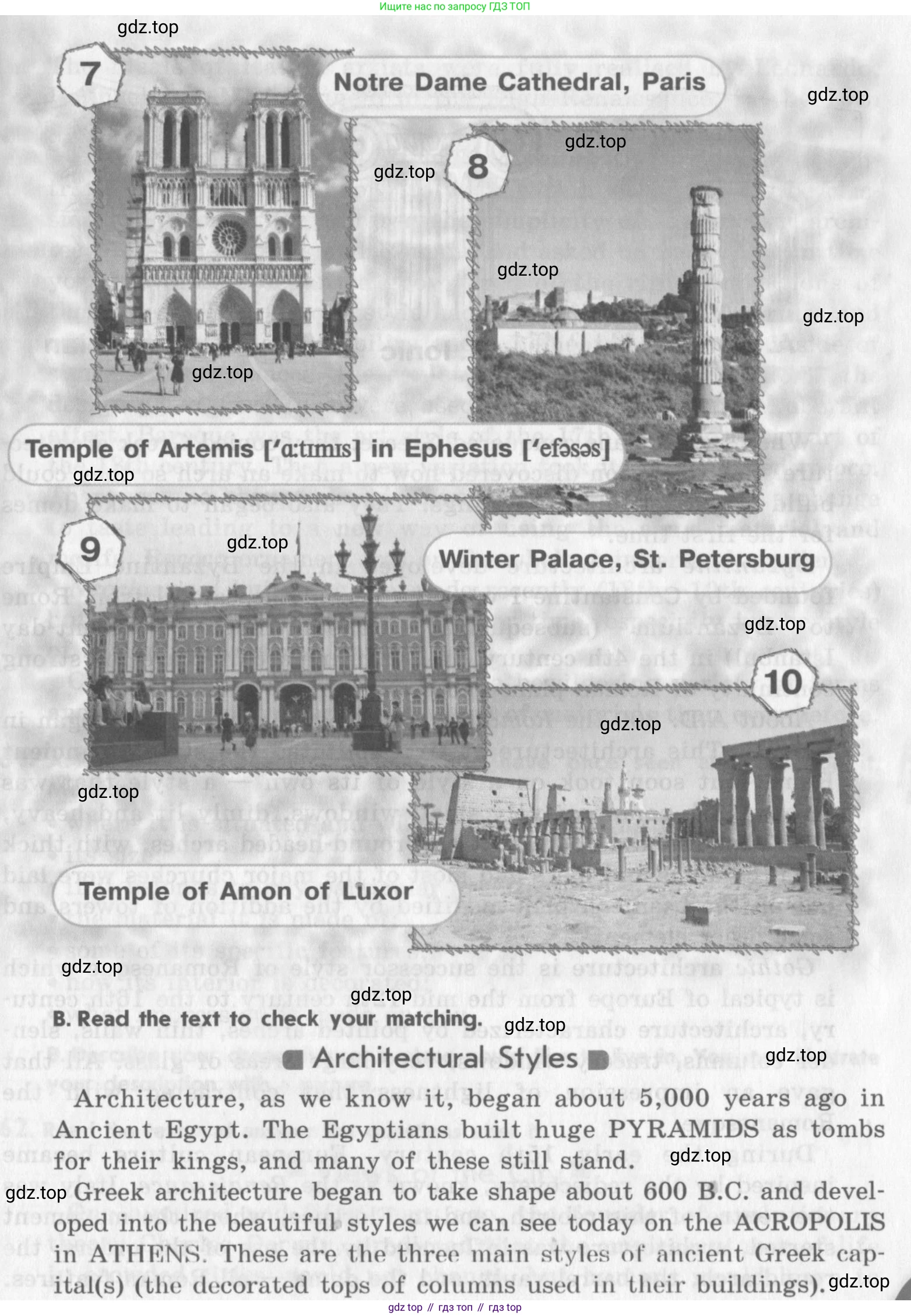
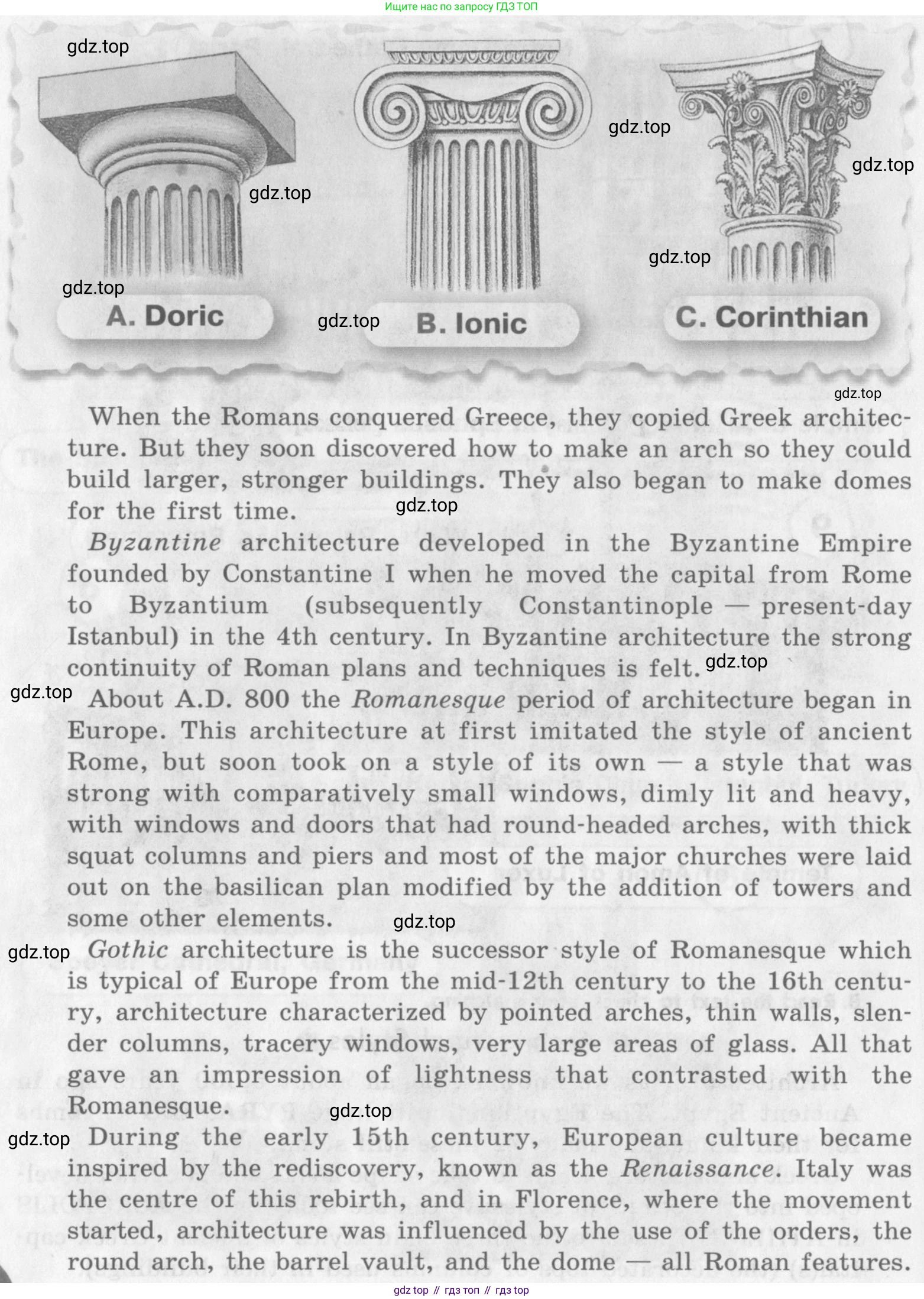
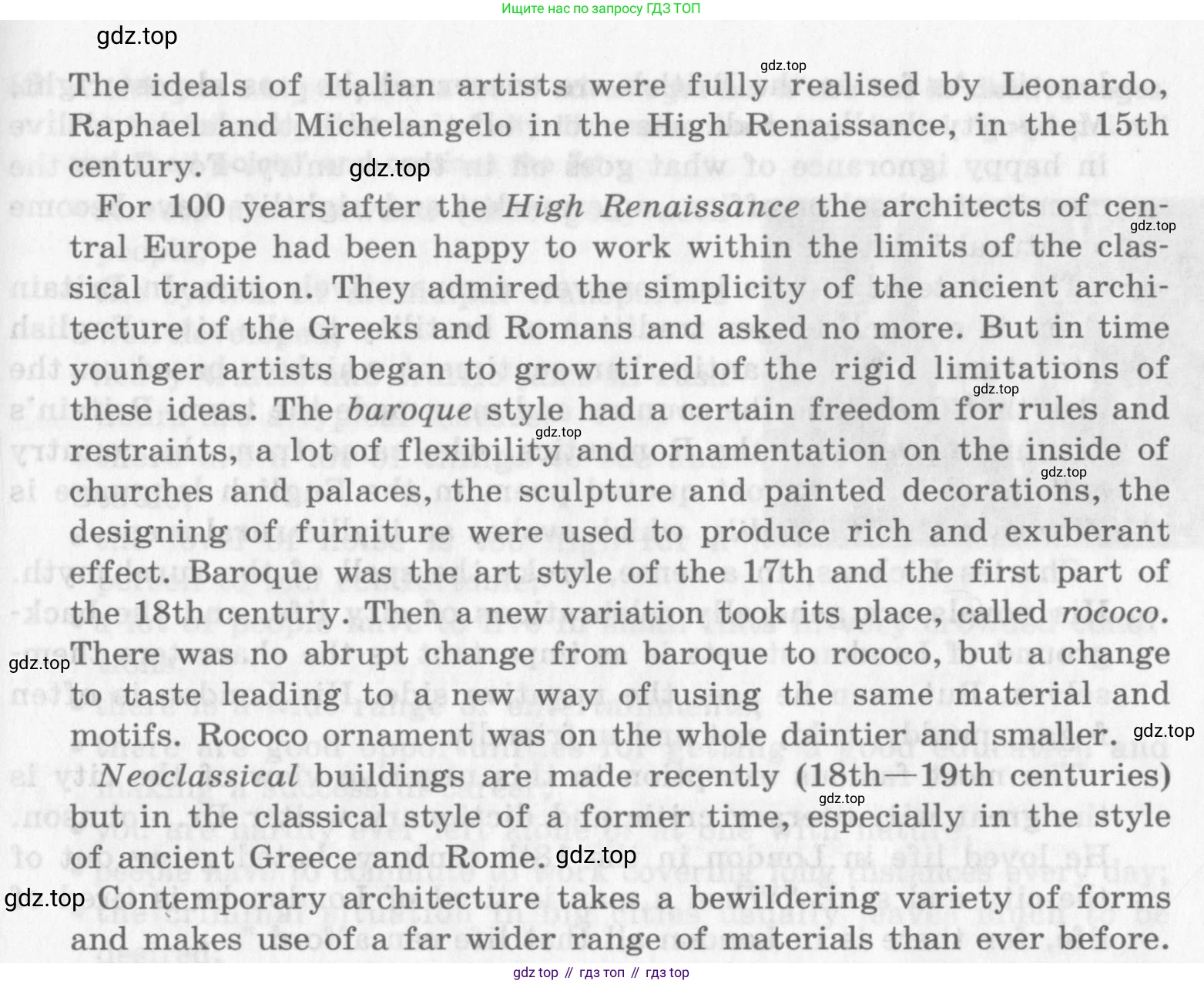
60. A. Try to match these works of architecture (pp. 113–115) with their styles.
- a) Ancient Egyptian Style (2000 — 500 B.C.)
- b) Ancient Greek Style (600s — 100 B.C.)
- c) Ancient Roman Style (100 B.C. — A.D. 400s)
- d) Byzantine Style (A.D. 400s — 1453)
- e) Romanesque Style (A.D. 800s — 1100s)
- f) Gothic Style (1100s — 1400s)
- g) Renaissance Style (1400s — 1500s)
- h) Baroque and Rococo Styles (1600s — 1700s)
- i) Neoclassical Style (1800s — 1900s)
- j) Modern and Postmodern Styles
1 The Cathedral of Florence
2 Pont du Gard aqueduct [ækwidʌkt]
3 The Academy in Athens
4 The building in Munich [mju:nɪk], Germany
5 Santa (Hagia) Sophia Church, Istanbul, Turkey
6 Speyer Cathedral, Germany
7 Notre Dame Cathedral, Paris
8 Temple of Artemis [ɑ:tɪmɪs] in Ephesus [ɛfəsəs]
9 Winter Palace, St. Petersburg
10 Temple of Amon of Luxor
B. Read the text to check your matching.
■ Architectural Styles ■
Architecture, as we know it, began about 5,000 years ago in Ancient Egypt. The Egyptians built huge PYRAMIDS as tombs for their kings, and many of these still stand.
Greek architecture began to take shape about 600 B.C. and developed into the beautiful styles we can see today on the ACROPOLIS in ATHENS. These are the three main styles of ancient Greek capitals (the decorated tops of columns used in their buildings).
| A. Doric | B. Ionic | C. Corinthian |
When the Romans conquered Greece, they copied Greek architecture. But they soon discovered how to make an arch so they could build larger, stronger buildings. They also began to make domes for the first time.
Byzantine architecture developed in the Byzantine Empire founded by Constantine I when he moved the capital from Rome to Byzantium (subsequently Constantinople — present-day Istanbul) in the 4th century. In Byzantine architecture the strong continuity of Roman plans and techniques is felt.
About A.D. 800 the Romanesque period of architecture began in Europe. This architecture at first imitated the style of ancient Rome, but soon took on a style of its own — a style that was strong with comparatively small windows, dimly lit and heavy, with windows and doors that had round-headed arches, with thick squat columns and piers and most of the major churches were laid out on the basilican plan modified by the addition of towers and some other elements.
Gothic architecture is the successor style of Romanesque which is typical of Europe from the mid-12th century to the 16th century, architecture characterized by pointed arches, thin walls, slender columns, tracery windows, very large areas of glass. All that gave an impression of lightness that contrasted with the Romanesque.
During the early 15th century, European culture became inspired by the rediscovery, known as the Renaissance. Italy was the centre of this rebirth, and in Florence, where the movement started, architecture was influenced by the use of the orders, the round arch, the barrel vault, and the dome — all Roman features.
The ideals of Italian artists were fully realised by Leonardo, Raphael and Michelangelo in the High Renaissance, in the 15th century.
For 100 years after the High Renaissance the architects of central Europe had been happy to work within the limits of the classical tradition. They admired the simplicity of the ancient architecture of the Greeks and Romans and asked no more. But in time younger artists began to grow tired of the rigid limitations of these ideas. The Baroque style had a certain freedom for rules and restraints, a lot of flexibility and ornamentation on the inside of churches and palaces, the sculpture and painted decorations, the designing of furniture were used to produce rich and exuberant effect. Baroque was the art style of the 17th and the first part of the 18th century. Then a new variation took its place, called rococo. There was no abrupt change from baroque to rococo, but a change to taste leading to a new way of using the same material and motifs. Rococo ornament was on the whole daintier and smaller.
Neoclassical buildings are made recently (18th–19th centuries) but in the classical style of a former time, especially in the style of ancient Greece and Rome.
Contemporary architecture takes a bewildering variety of forms and makes use of a far wider range of materials than ever before.
Решение. №60 (с. 113)


Решение 2. №60 (с. 113)
60. A. Попытайтесь сопоставить эти архитектурные произведения с их стилями.
Ответ:
1. The Cathedral of Florence - g) Renaissance Style
1. Собор во Флоренции - g) Стиль Ренессанс
2. Pont du Gard aqueduct - c) Ancient Roman Style
2. Акведук Пон-дю-Гар - c) Древнеримский стиль
3. The Academy in Athens - i) Neoclassical Style
3. Афинская академия - i) Неоклассический стиль
4. The building in Munich, Germany - j) Modern and Postmodern Styles
4. Здание в Мюнхене, Германия - j) Стили модерн и постмодерн
5. Santa (Hagia) Sophia Church, Istanbul, Turkey - d) Byzantine Style
5. Собор Святой Софии, Стамбул, Турция - d) Византийский стиль
6. Speyer Cathedral, Germany - e) Romanesque Style
6. Шпайерский собор, Германия - e) Романский стиль
7. Notre Dame Cathedral, Paris - f) Gothic Style
7. Собор Парижской Богоматери, Париж - f) Готический стиль
8. Temple of Artemis in Ephesus - b) Ancient Greek Style
8. Храм Артемиды в Эфесе - b) Древнегреческий стиль
9. Winter Palace, St. Petersburg - h) Baroque and Rococo Styles
9. Зимний дворец, Санкт-Петербург - h) Стили барокко и рококо
10. Temple of Amon of Luxor - a) Ancient Egyptian Style
10. Храм Амона в Луксоре - a) Древнеегипетский стиль
Другие задания:
Помогло решение? Оставьте отзыв в комментариях ниже.
Присоединяйтесь к Телеграм-группе @top_gdz
ПрисоединитьсяМы подготовили для вас ответ c подробным объяснением домашего задания по английскому языку за 11 класс, для упражнения номер 60 расположенного на странице 113 к Учебник (Student's book) 2014 года издания для учащихся школ и гимназий.
Теперь на нашем сайте ГДЗ.ТОП вы всегда легко и бесплатно найдёте условие с правильным ответом на вопрос «Как решить ДЗ» и «Как сделать» задание по английскому языку к упражнению №60 (с. 113), авторов: Афанасьева (Ольга Васильевна), Михеева (Ирина Владимировна), ФГОС (старый) углублённый уровень обучения учебного пособия издательства Просвещение.

















